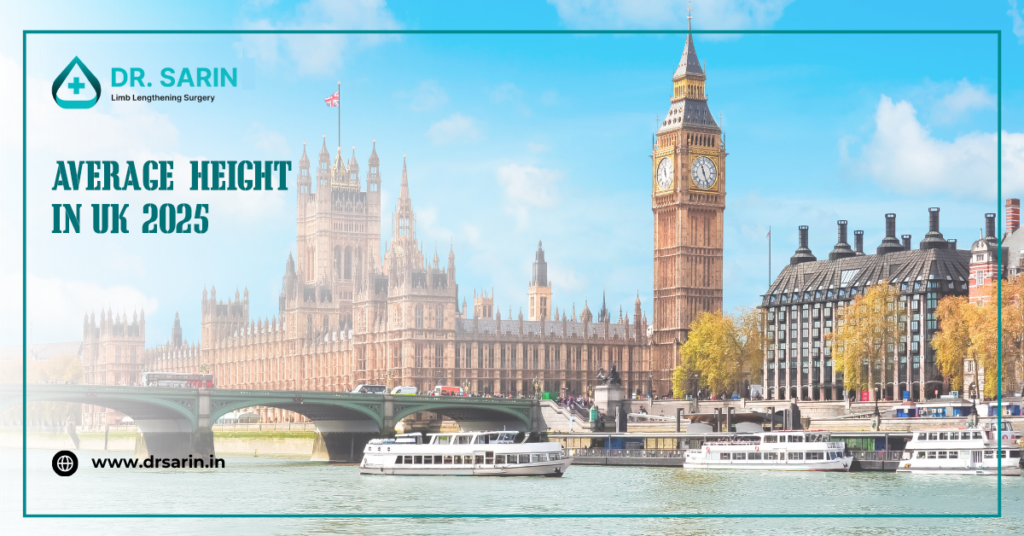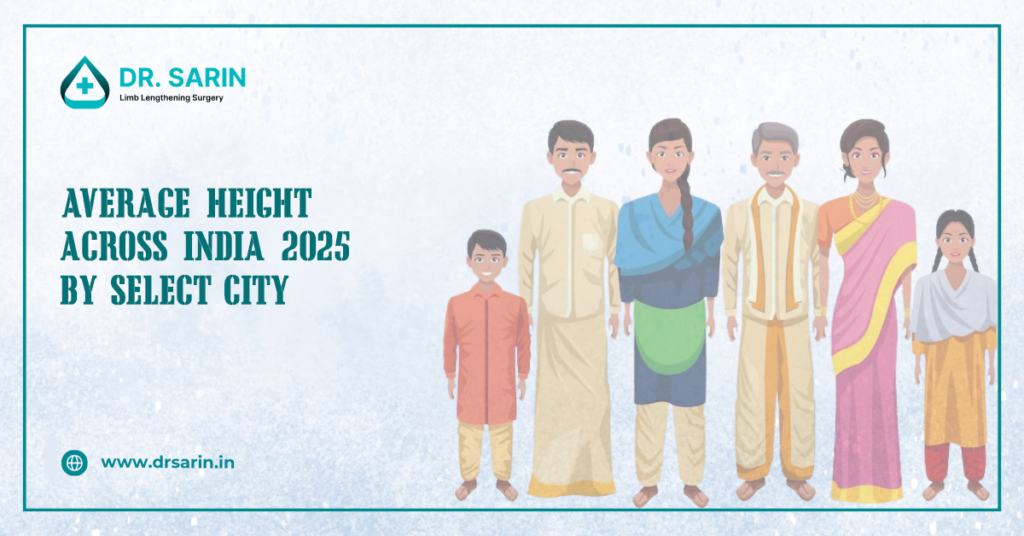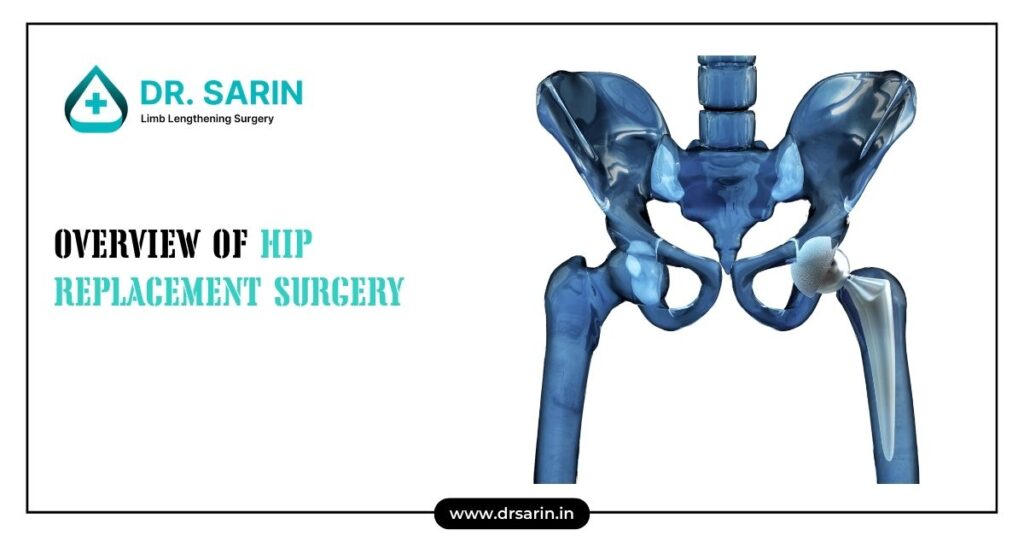Average Height of UK 2025

The average height of a population serves as a key indicator of overall health and nutrition levels within a country. In the UK, this metric has shown a steady increase over the years, driven by improvements in living conditions, advancements in healthcare, and enhanced dietary habits. Understanding these trends not only provides insight into public health but also informs policies aimed at fostering a healthier future. Current Average Height of UK (2025) As of 2025, the average height for adults in the UK is as follows: These figures represent a gradual rise over recent decades, reflecting the positive impact of various societal factors. Factors Affecting Average Height in the UK Several elements contribute to the average height of individuals in the UK: Historical Trends in Height Over the past century, historical data indicates a consistent increase in average height across the UK. This trend can be attributed to enhanced living standards, medical advancements, and improved nutrition. Notably, the post-World War II era saw significant improvements in public health policies, which have had lasting effects on population height. Regional Variations While national averages provide a broad overview, there are regional variations in average height within the UK. These differences can be influenced by local dietary habits, socioeconomic conditions, and genetic diversity. For example, studies have shown that individuals in urban areas may have different average heights compared to those in rural regions, often due to lifestyle and dietary differences. The Impact of Global Trends In addition to local factors, global trends such as increased migration and cultural exchange can influence dietary habits and health practices, potentially affecting average height. As the UK becomes more multicultural, the blending of dietary practices may lead to new health outcomes. Conclusion Understanding the average height and the factors that influence it is essential for developing policies aimed at improving public health and nutrition. By addressing these areas, we can continue to support the positive trend in average height and overall well-being in the UK. As we move forward, ongoing research and community engagement will be crucial in ensuring that all individuals have the opportunity to reach their full height potential, contributing to a healthier society overall. Additional Resources For those interested in exploring this topic further, consider the following resources: NHS Guidelines on Nutrition: NHS Nutrition Public Health England Reports on Height Trends: PHE Reports Research on Genetics and Height: Genetics Home Reference
Average Height Across India 2025 by Select City

Height serves as an important measure of overall health, nutrition, and well-being, with variations seen across different cities and regions in India. This article delves into the average height in various Indian cities for 2025, examining the trends and factors that contribute to these disparities. The information gathered offers valuable perspectives on lifestyle, genetics, and nutritional habits in India. Average Height in India: National Overview On a national level, the average height in India has shown gradual increases over the past decades. While genetics play a significant role in determining height, socioeconomic factors, access to healthcare, and dietary habits also have substantial impacts. As of 2025, the average height for males and females in India is approximately: Men: 5 feet 5 inches (165 cm) Women: 5 feet (152 cm) However, these figures can fluctuate widely depending on specific urban and rural settings. Factors Influencing Height Variation in India Height is influenced by a combination of genetic and environmental factors. In India, socioeconomic status, dietary diversity, and healthcare access all contribute significantly to height variations. Key influences include: City-Wise Analysis of Average Heights in India (2025) 1. New Delhi In the capital city, a diverse population and relatively high standard of living contribute to a higher-than-average height. However, factors like pollution may hinder optimal growth. In 2024, average heights are: Men: 5 feet 6 inches (168 cm) Women: 5 feet 1 inch (155 cm) 2. Mumbai Mumbai, known for its bustling urban life, has a mixed demographic, with people from various socioeconomic backgrounds. Access to nutritious food is more widespread, though stress and pollution remain concerns. Men: 5 feet 5 inches (165 cm) Women: 5 feet (152 cm) 3. Chennai Chennai’s population sees slightly lower average heights, partly due to dietary habits and regional genetics. The tropical climate and diet rich in rice and less protein might impact height trends. Men: 5 feet 4 inches (163 cm) Women: 4 feet 11 inches (150 cm) 4. Kolkata With a strong cultural emphasis on a carb-heavy diet, the population in Kolkata tends to have shorter average heights. The city’s lifestyle, dietary habits, and genetics contribute to this trend. Men: 5 feet 4.5 inches (164 cm) Women: 4 feet 11 inches (150 cm) 5. Bengaluru Known for its tech industry and youthful demographic, Bengaluru’s average height is slightly higher due to access to varied diets and healthcare. Men: 5 feet 5.5 inches (166 cm) Women: 5 feet (152 cm) 6. Ahmedabad Ahmedabad shows moderate height averages. While the diet is generally nutritious, it is high in carbohydrates and fats, which may influence growth. Men: 5 feet 5 inches (165 cm) Women: 5 feet (152 cm) Rural vs. Urban Height Trends There’s a clear distinction in average height between urban and rural areas. Urban residents tend to be taller due to better healthcare facilities and balanced diets. Conversely, rural areas, especially those with limited access to nutritious food, report lower averages. Bridging this gap remains essential for enhancing health equity. How Socioeconomic Conditions Affect Average Heights Socioeconomic conditions are one of the biggest factors influencing height. Areas with higher income levels and better infrastructure offer more resources for health and well-being. In cities, access to fortified foods, regular medical check-ups, and adequate housing contribute to better growth outcomes in children and adolescents. Comparison with Global Averages When compared internationally, India’s average height is still below the global average. Countries with advanced healthcare systems and higher protein intake generally have taller populations. Analyzing these differences highlights the importance of healthcare and nutritional investments in raising the national average. Conclusion While genetics set a base, lifestyle, nutrition, and healthcare largely determine the actual growth of individuals across different regions. India can work towards a higher average height by increasing awareness of balanced diets and improving healthcare access, especially in rural and low-income urban areas. The study of Indian average height by city sheds light on how public health initiatives can continue to improve nationwide.
How Much Height Can You Gain Safely with Limb Lengthening?

The surgery has become famous for those looking to increase their height. This procedure involves surgically lengthening the bones in the legs, allowing individuals to grow taller over time. But how much height can you safely gain through this process? It can typically add 2 to 3 inches (5 to 8 cm) of height in one procedure. However, with multiple surgeries, some people have achieved an increase of up to 6 inches (15 cm). It’s important to note that the height gained depends on the patient’s body and bone health. Height increase surgery is a complex procedure that requires significant recovery time. The process involves gradually stretching the bones using an external device, encouraging bone growth. While surgery is generally safe when performed by a qualified surgeon, patients must be mindful of potential risks, such as infection, nerve damage, or prolonged recovery. Limb surgery can be a safe and effective way to increase height, with typical gains ranging from 2 to 6 inches. Consulting with a surgeon and understanding the potential risks are essential steps for anyone considering this procedure.
Indian children may no longer outgrow parents

For years, it has been common for children to grow taller than their parents, especially in countries where living conditions, nutrition, and healthcare have improved. However, recent studies suggest this trend may slow down in India. Indian children, who were once expected to surpass their parents in height, may no longer follow this pattern. The factors behind this stagnation in height are complex, involving nutrition, healthcare, socio-economic disparities, and lifestyle changes. Key Factors Behind Height Stagnation in India 1. Malnutrition Malnutrition remains a major obstacle to growth in India. Even though the country has made significant strides in food production, a large portion of the population, particularly in rural areas, still lacks access to nutritious food. The lack of essential nutrients such as vitamins, minerals, and proteins during critical growth can lead to stunted growth. Children who do not receive proper nutrition during their early years may not reach their full potential. 2. Socio-economic Disparities Economic inequality is another significant factor. Children from low-income families often face higher risks of stunted growth due to limited access to healthcare, clean water, and proper sanitation. In contrast, children from wealthier families in urban areas may experience better growth due to improved living conditions. This socio-economic divide results in many Indian children falling short of their potential height. 3. Changing Diets The modern Indian diet, particularly in urban areas, is shifting towards high-calorie, low-nutrient foods. The increasing consumption of processed and fast foods, high in unhealthy fats and sugars, contributes to poor health outcomes. These dietary changes are not providing the necessary nutrients for children’s growth and may be playing a role in the height stagnation seen across the country. 4. Healthcare and Sanitation Frequent Illnesses, especially in areas with inadequate sanitation, also affect physical development. Diseases such as diarrhea, prevalent in regions with poor water quality, can prevent the absorption of essential nutrients. As a result, children in these areas are more likely to experience growth disruptions, further contributing to the height stagnation trend. How Does the Indian Average Height Compare Globally? The Indian Average Height for men is about 5’5″ (165 cm), and for women, it’s around 5’0″ (152 cm). These averages are lower than in many Western and East Asian countries. This difference is often attributed to factors like malnutrition, limited access to healthcare, and the impact of socio-economic conditions. While some improvement is seen in urban areas, particularly among younger generations, the overall trend remains concerning. What Can Be Done? Addressing the issue of height stagnation requires a multifaceted approach, including: Conclusion While the trend of children outgrowing their parents has been common in many countries, India is witnessing a potential stagnation in height. Factors like malnutrition, socio-economic disparities, changing diets, and limited access to healthcare are contributing to this issue. Addressing these challenges is critical to ensuring that future generations in India can reach their full physical potential and experience improved overall health.
What’s The Average Height Per Country?

Height is one of the most visible traits that vary across populations globally. Multiple factors can influence it, including genetics, environment, nutrition, and healthcare. Countries exhibit different average heights, which can also reflect historical changes in living conditions. Over the years, numerous studies on the average height of individuals in various countries have revealed interesting global trends and differences. Factors Influencing Average Height Before we dive into the numbers, it’s essential to understand the factors influencing average height. The most prominent factors include: Average Height Across Various Countries Let’s explore the average height in different parts of the world: 1. India India is one of the most populous countries in the world, and its average height reflects its diverse genetics and varying access to nutrition. The Indian average height for men is approximately 5’5″ (165 cm), and for women, it is around 5’0″ (152 cm). Various studies suggest that while genetics play a role, factors such as malnutrition, socio-economic disparities, and healthcare access contribute to the lower average height compared to Western countries. However, in urban areas where diets are improving, the younger generations are showing slight increases in height. 2. The Netherlands The Dutch are among the tallest people in the world. The average height for men is approximately 6 feet (183 cm), while women stand at an average height of around 5’7″ (170 cm). Various studies have shown that genetics and a rich, dairy-heavy diet contribute to their taller-than-average stature. 3. Denmark Like the Netherlands, Denmark also ranks among the countries with the tallest people. The average height for Danish men is about 5’11” (181 cm), and for women, it’s about 5’7″ (169 cm). The high standard of living and access to healthcare and nutritious food are primary contributors to their average height. 4. United States In the U.S., the average height for men is about 5’9″ (175 cm), while for women, it’s around 5’4″ (162 cm). Although Americans were once among the tallest populations globally, their average height has remained relatively stagnant over the last few decades, possibly due to increased obesity and other lifestyle-related health issues. 5. Japan Japan has a shorter average height compared to Western nations. The average height for Japanese men is about 5’7″ (170 cm), and for women, it’s approximately 5’2″ (158 cm). The traditional Japanese diet, rich in vegetables and fish but low in dairy, has contributed to their shorter stature. However, with changing diets and improved nutrition, younger generations in Japan are showing increases in height. 6. Brazil In Brazil, the average height is around 5’8″ (173 cm) for men and 5’3″ (160 cm) for women. Brazil’s ethnic diversity, which includes a mix of European, African, and indigenous ancestry, results in a broad range of heights across the population. 7. China In China, the average height for men is around 5’7″ (170 cm), and for women, it’s about 5’3″ (160 cm). Like India, China’s rapid urbanization and economic development have led to improved access to nutrition and healthcare, increasing average height, particularly among the younger population. 8. South Africa South Africa, known for its diverse population, has an average height of around 5’7″ (170 cm) for men and 5’2″ (158 cm) for women. The population’s mixed ancestry and varying socio-economic conditions contribute to these averages. 9. Australia In Australia, the average height for men is about 5’10” (178 cm), and for women, it’s around 5’6″ (164 cm). With access to good healthcare, nutritious food, and active lifestyles, Australians rank among the taller populations worldwide. Global Trends in Height Over the past century, the average height in many countries has steadily increased, primarily due to better living conditions and improved nutrition. European countries have seen remarkable increases in average height, while countries in Asia, Africa, and Latin America have shown slower growth trends. In developing countries like India, malnutrition and unequal healthcare access are significant factors contributing to shorter stature. However, there are cases where the average height has plateaued or even decreased in specific populations. In the U.S., for instance, the average height has remained relatively stagnant in recent decades, potentially due to the rising rates of obesity and other health issues that affect growth. Final Thoughts The average height of individuals varies widely from country to country and is influenced by many factors, including genetics, nutrition, healthcare, and living conditions. While countries like the Netherlands and Denmark boast some of the tallest populations in the world, nations like India, Japan, and China have relatively shorter averages. In India, the average height reflects the country’s socio-economic challenges and disparities in healthcare and nutrition. While improvements are being made, especially in urban regions, the Indian average height is still lower than in many Western nations. Understanding these trends can provide valuable insights into the health and development of populations globally. As research continues, we may see further changes in these averages, particularly in countries undergoing rapid economic development and improving living conditions.
Average Height and Weight chart for Indian Man and Woman

Understanding the average height and weight of men and women can provide insights into a population’s general health and well-being. In India, these averages vary slightly depending on region, diet, and lifestyle. Below is a guide to the average height and weight for Indian men and women, helping you understand where you stand regarding national averages. 1. Average Height and Weight for Indian Men The average height of an Indian man is approximately 5 feet 8 inches (172 cm), while the average weight ranges between 65-75 kg. However, this can differ based on region, with men from northern states often being taller than those from the other areas due to dietary and environmental factors. Age Group Average Height (cm) Average Weight (kg) 18-25 167-172 60-70 26-35 168-173 65-75 36-45 167-172 68-78 46-60 165-170 70-80 2. Average Height and Weight for Indian Women The average height of an Indian woman is around 5 feet 3 inches (160 cm), while her average weight is typically between 55-65 kg. Like men, women’s height and weight can vary based on nutrition and location. Age Group Average Height (cm) Average Weight (kg) 18-25 152-160 50-60 26-35 154-162 55-65 36-45 153-161 58-68 46-60 151-159 60-70 3. Factors Influencing Indian Average Weight and Height While genetics play a significant role in determining weight and height, other factors such as nutrition, lifestyle, and healthcare access also contribute to variations. For instance, individuals from urban areas often have better access to healthcare and balanced diets, which positively impacts their growth and development. Additionally, regular physical activity helps maintain a healthy weight. 4. Indian Average Height Trends Indian average height has gradually increased over the years due to improvements in nutrition and healthcare. Younger generations, especially in urban areas, tend to be taller than previous generations. However, despite this growth, Average height remains slightly below global averages. Conclusion Knowing the average height and weight of Indian men and women can help individuals assess their physical health relative to national standards. While genetic factors play a crucial role, lifestyle choices such as a balanced diet and regular exercise are essential in maintaining healthy weight and height proportions. Remember that these averages are just guidelines, and individual health goals should always prioritize overall well-being over societal standards.
Psychological Impact Of Limb-Lengthening Surgery

Limb-lengthening is a complex orthopedic procedure that can significantly improve a person’s physical stature, correct deformities, or address discrepancies in limb length. However, while the surgery offers physical benefits, it can also have a profound psychological impact on patients undergoing the procedure. Understanding these effects is crucial for patients and healthcare providers to ensure a smoother recovery process and better mental health outcomes. Initial Emotional Strain and Anxiety Undergoing limb surgery is a major decision that can trigger anxiety and emotional stress. The anticipation of pain, potential complications, and uncertainty about the outcome can cause considerable anxiety before the surgery. Patients might worry about the long recovery process, how they will manage pain, and whether the results will meet their expectations. This apprehension can lead to fear and nervousness in the pre-operative phase. Pain and Discomfort During Recovery Post-surgery, patients often experience significant pain, discomfort, and restricted mobility, which can affect their mental well-being. The long and usually uncomfortable recovery period can lead to frustration, helplessness, and irritability. Pain can make patients feel overwhelmed, affecting their ability to stay positive, and might even lead to temporary feelings of sadness or depression. Impact on Self-Image and Confidence It can greatly influence a person’s self-image. The procedure is life-changing for some, boosting self-esteem and confidence, especially if they’ve long struggled with height-related insecurities. However, the physical changes during recovery, such as scars, swelling, or the use of external fixators, can cause temporary body image concerns. This shift can make patients feel self-conscious, anxious, or uncertain about their appearance. Social Isolation and Emotional Challenges The lengthy recovery period often requires limited physical activity and can restrict social interactions. As a result, patients may feel isolated from their regular social circles, leading to loneliness or sadness. This isolation can be particularly challenging, especially for individuals who are used to being active and social. Psychological Impact of Long-term Outcomes For many, the outcome of surgery is a source of immense satisfaction and improved self-esteem. However, patients who don’t achieve the desired results or who face complications might experience disappointment, regret, or even depression. Coping with any unexpected results requires strong psychological resilience and support. Importance of Psychological Support Given the potential psychological impact of limb-lengthening surgery, mental health support plays a crucial role in the overall treatment plan. Pre-operative counseling, ongoing psychological support during recovery, and post-operative therapy can help patients manage expectations, cope with pain, and adapt to changes in their self-image. Conclusion While the procedure can lead to increased confidence and self-esteem, it may also present emotional challenges, such as anxiety, pain management, and body image concerns. Understanding these psychological effects and seeking the necessary support can significantly enhance the journey toward physical and emotional recovery.
Hip Replacement Surgery

Hip replacement surgery, also known as hip arthroplasty, is a common procedure aimed at relieving hip pain and improving joint function. This surgery involves removing the damaged sections of the hip joint and replacing them with artificial components, typically made from metal, plastic, or ceramic materials. Hip replacement is generally considered for individuals suffering from severe arthritis, hip fractures, or other degenerative joint conditions that affect their mobility and quality of life. By restoring the function of the hip joint, this surgery can allow patients to return to their everyday activities and significantly reduce their pain levels. There are two primary types of hip replacement surgeries: total hip replacement (THR) and partial hip replacement. In a total hip replacement, both the ball (femoral head) and the socket (acetabulum) of the hip joint are replaced. Partial hip replacement typically involves replacing only the femoral head. The choice between these procedures depends on the extent of damage to the hip joint, the patient’s age, overall health, and activity level. Why is Hip Replacement Surgery Needed? Hip replacement surgery is typically recommended for individuals who experience chronic hip pain and limited mobility that doesn’t improve with non-surgical treatments such as physical therapy, medications, or injections. The most common reason for needing hip replacement is osteoarthritis, a degenerative joint disease that wears down the cartilage between bones, leading to pain and stiffness. Other conditions that may necessitate hip replacement include rheumatoid arthritis, hip fractures, avascular necrosis (a condition where the blood supply to the bone is reduced, causing the bone to die), and developmental hip dysplasia. For many patients, hip pain can significantly interfere with daily activities such as walking, climbing stairs, and even resting. When hip joint deterioration begins to affect sleep, work, or basic movements, hip replacement surgery can offer a long-term solution. The surgery is designed to alleviate pain, restore range of motion, and improve overall function, allowing patients to lead a more active lifestyle. Preparing for Hip Replacement Surgery Preparation is a key factor in ensuring a successful hip replacement surgery and smooth recovery. Before the surgery, patients will undergo a thorough medical evaluation, which includes blood tests, X-rays, and a physical examination to ensure they are fit for the procedure. The surgeon may also suggest losing weight, quitting smoking, or engaging in a preoperative exercise regimen to improve overall health and muscle strength. This preparation can help to optimize the outcome of the surgery. Patients should inform their medical team of any medications they are taking, as some drugs may need to be paused or adjusted before the surgery. Additionally, preparing the home environment for post-surgery recovery is important. Patients may need to arrange for assistive devices such as crutches, walkers, or grab bars in the bathroom. It’s also advisable to have a support system in place, as some assistance will be required for daily tasks during the initial recovery period. What to Expect During Hip Replacement Surgery During hip replacement surgery, patients are typically placed under general anesthesia, though in some cases, spinal or epidural anesthesia may be used. The surgery usually takes about 1-2 hours. In a standard procedure, the surgeon makes an incision over the hip and carefully removes the damaged bone and cartilage. The artificial joint components (prostheses) are then inserted to replicate the movement of a healthy hip joint. Depending on the type of surgery and the surgeon’s preference, either cemented or uncemented prosthetics may be used. Minimally invasive techniques, which involve smaller incisions and less muscle disruption, have become more common and may result in quicker recovery times. After the surgery, patients will be moved to a recovery room where their vital signs are monitored. Most patients stay in the hospital for 1-3 days, but the recovery time varies depending on the individual’s overall health and the complexity of the surgery. In the days following surgery, physical therapy will begin to help patients regain strength and mobility. Although full recovery can take several months, most patients experience significant pain relief and improved joint function within a few weeks of surgery. With proper care, a hip replacement can last 15-20 years, allowing individuals to enjoy a better quality of life for years to come.
Factors That Can Influence the Price of Limb Lengthening Surgery in India

Limb lengthening surgery is a complex procedure that involves the gradual extension of bones to correct discrepancies or enhance height. In India, the cost of this surgery can vary significantly due to several factors. Understanding these factors can help patients and their families make informed decisions when planning for the procedure. Here’s a breakdown of the key elements that can influence the price of limb lengthening surgery in India. Hospital Reputation and Infrastructure The reputation and infrastructure of the hospital where the surgery is performed are major factors influencing the cost. Hospitals with advanced technology, state-of-the-art equipment, and a strong track record of successful outcomes tend to charge higher fees. Moreover, well-established hospitals often provide better post-operative care, which is crucial for a procedure as delicate as limb lengthening. The Expertise and Experience of Medical Professionals The surgeon’s expertise and experience are critical determinants of the surgery’s cost. Surgeons with extensive experience and specialization in limb lengthening procedures often charge higher fees due to their proven track record and the complexity of the surgery. Additionally, the involvement of a skilled surgical team, including anesthetists and physiotherapists, also adds to the overall cost. The Type and Frequency of Diagnostic Procedures Before the surgery, patients undergo various diagnostic tests such as X-rays, MRIs, and blood tests to assess their suitability for the procedure and plan the surgery. The type and frequency of these diagnostic procedures can significantly impact the overall cost. Advanced imaging techniques or repeated tests to monitor progress during the treatment phase can increase expenses. The Choice of Treatment Modality Limb lengthening can be performed using different techniques, such as the Ilizarov method, intramedullary nails, or external fixators. The choice of treatment modality greatly affects the cost of the surgery. Some methods require more advanced equipment and longer hospital stays, which can drive up the price. The complexity of the chosen technique also influences the length of recovery and the need for follow-up procedures, adding to the overall cost. Medication Costs Medication is an essential part of the limb lengthening process, both pre- and post-surgery. The cost of pain management, antibiotics, and other necessary drugs can vary depending on the brand, dosage, and duration of treatment. High-quality medications, often prescribed to ensure a smoother recovery and minimize the risk of complications, can increase the overall cost of the surgery. Duration of Treatment The duration of the treatment process, which includes both the surgery and the post-operative recovery period, can affect the overall cost. Limb lengthening is a gradual process that can take several months to complete, especially during the bone consolidation phase. Prolonged treatment may lead to additional hospital visits, follow-up consultations, and extended use of medical devices, all contributing to higher expenses. Geographical Location The geographical location of the hospital also plays a significant role in determining the cost of limb lengthening surgery. Hospitals in metropolitan cities like Delhi, Mumbai, or Bangalore tend to charge more due to higher operational costs, demand for specialized medical services, and access to advanced technology. In contrast, hospitals in smaller cities or towns might offer the procedure at a lower cost, albeit with potentially limited resources or less experienced medical professionals. Hospitalization Expenses Hospitalization expenses, including room charges, nursing care, and other in-hospital services, can add substantially to the overall cost of the surgery. Private rooms, luxury amenities, and extended stays can significantly increase hospitalization costs. Patients should consider these factors when choosing their hospital, as a comfortable and supportive environment is essential for recovery but can also raise the cost. Government Policies and Subsidies Government policies and subsidies can sometimes influence the cost of limb lengthening surgery in India. In some cases, government hospitals or schemes may offer the surgery at a subsidized rate for eligible patients. However, these options might come with longer waiting periods or limited access to advanced treatment modalities. Understanding available government support can help in reducing the financial burden of the surgery. Medical Tourism Packages India is a popular destination for medical tourism, and many hospitals offer comprehensive packages that include surgery, accommodation, transportation, and post-operative care. These packages can be cost-effective for international patients seeking high-quality medical care at a lower cost compared to their home countries. However, the overall price of such packages can vary based on the inclusions, the hospital’s reputation, and the level of care provided. When considering limb lengthening surgery in India, it’s essential to take into account these various factors that can influence the overall cost. By carefully evaluating the hospital, medical professionals, treatment modalities, and additional expenses, patients can make informed decisions that align with their budget and healthcare needs.
Difference in Upper Extremity Limb Length

The upper extremity, comprising the arm, forearm, and hand, is a complex structure that facilitates a wide range of motions and functions. The skeletal anatomy includes the humerus, radius, and ulna, which are supported by a network of muscles, tendons, ligaments, and nerves. Proper alignment and length of these bones are crucial for optimal function and symmetry. Description Upper extremity limb length discrepancy (UELLD) refers to a condition where there is a noticeable difference in the length of the arms. This disparity can impact both cosmetic appearance and functional abilities, leading to challenges in performing daily activities. The discrepancy may be mild or severe, and its impact on the individual can vary widely. Accurate diagnosis and appropriate treatment are essential for managing the condition effectively. Cause Congenital Upper Limb Length Discrepancy Congenital UELLD is present at birth and can result from a variety of factors, including genetic mutations, developmental disturbances, or conditions affecting fetal growth. Common congenital conditions associated with UELLD include: Fibular Hemimelia: A rare congenital condition where part or all of the fibula bone is missing. Amniotic Band Syndrome: A condition caused by entanglement of the fetal limbs in fibrous amniotic bands, leading to restricted growth and development. Radial Club Hand: A condition characterized by the underdevelopment or absence of the radius bone, resulting in a shorter forearm. Congenital UELLD is often detected early in life, allowing for timely intervention and management. Acquired Limb Length Discrepancy Acquired UELLD develops after birth due to various factors, such as trauma, infection, or medical conditions. Common causes include: Trauma: Fractures or injuries to the growth plates in children can disrupt normal bone growth, leading to length discrepancies. Severe fractures may require surgical intervention to restore limb length and function. Infections: Bone infections (osteomyelitis) can damage growth plates or bone tissue, leading to discrepancies in limb length. Tumors: Both benign and malignant bone tumors can affect bone growth and development, resulting in length discrepancies. Neurological Conditions: Conditions like cerebral palsy can lead to muscle imbalances and skeletal deformities, contributing to UELLD. Symptoms The symptoms of UELLD can vary based on the severity of the discrepancy and the underlying cause. Common symptoms include: Visible Difference in Arm Length: One arm may appear noticeably shorter or longer than the other. Functional Limitations: Difficulty in performing tasks that require symmetrical arm movement, such as lifting, carrying, or reaching. Musculoskeletal Pain: Discrepancies in limb length can lead to compensatory movements and postural imbalances, causing pain in the shoulders, back, or neck. Asymmetrical Muscle Development: The shorter limb may develop differently in terms of muscle mass and strength compared to the longer limb. Psychosocial Impact: Visible limb length discrepancies can affect self-esteem and body image, particularly in children and adolescents. Diagnosis and Treatment Diagnosis of UELLD typically involves a thorough clinical examination, medical history review, and imaging studies such as X-rays or MRI scans to determine the extent and cause of the discrepancy. Treatment options depend on the severity of the condition and may include: Non-Surgical Management: For mild discrepancies, non-surgical approaches such as physical therapy, orthotics, and shoe lifts can help manage symptoms and improve function. Surgical Intervention: In cases of severe UELLD, surgical procedures like limb lengthening, bone grafting, or corrective osteotomies may be necessary to restore symmetry and function. Early diagnosis and intervention are crucial in managing UELLD effectively, minimizing complications, and improving the quality of life for affected individuals.

